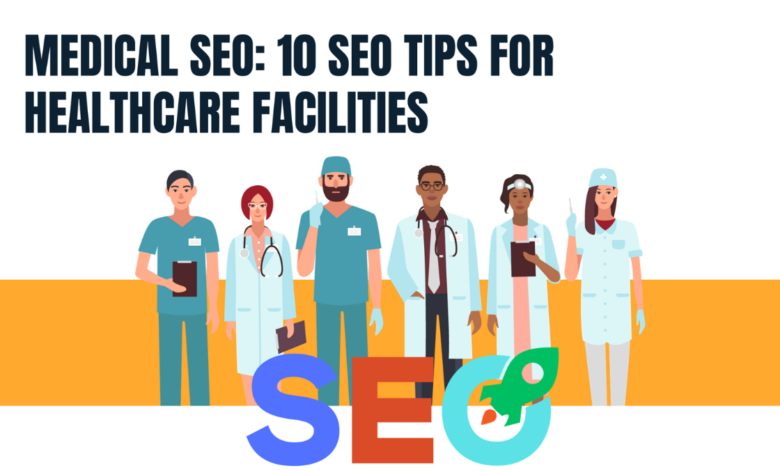Healthcare SEO: Boosting Your Practice in the Digital Age

In today’s fast-paced world,healthcare seo where digital presence can make or break a business, healthcare providers are not exempt from the need to stand out online. Healthcare SEO, or search engine optimization, has emerged as a crucial strategy for medical practices, clinics, and hospitals striving to attract more patients and improve their online visibility. This comprehensive guide will delve into the nuances of healthcare SEO, exploring its significance, strategies, and best practices to ensure your practice thrives in the competitive online landscape.
Understanding Healthcare SEO
What is Healthcare SEO?

Healthcare SEO is the practice of optimizing a healthcare website to rank higher in search engine results pages (SERPs) and attract more relevant traffic. It involves tailoring content and technical elements of a website to meet the needs of search engines like Google, Bing, and Yahoo, as well as the needs of patients searching for medical services. The ultimate goal is to make sure your practice appears prominently when potential patients search for relevant medical information or services.
SEO for healthcare is a specialized field that takes into account the unique aspects of medical content, such as the need for accuracy, compliance with regulations, and user engagement. Unlike general SEO, healthcare SEO requires an understanding of medical terminology, patient behavior, and local SEO to effectively connect with the target audience.
Why Healthcare SEO is Crucial
In the digital age, most people turn to the Internet when they need medical information or are looking for healthcare providers. If your practice does not rank well on search engines, you risk missing out on potential patients who may choose a competitor with a more prominent online presence. Effective healthcare SEO ensures that your practice is easily discoverable when patients search for relevant keywords.
Additionally, healthcare SEO helps build trust and credibility. A well-optimized website not only attracts visitors but also provides valuable information that can position your practice as a trusted authority in your field. This trust is crucial in healthcare, where patients need to feel confident in their choices of providers.
The Components of Healthcare SEO
Healthcare SEO encompasses a variety of components that work together to improve your online visibility. These include:
- Keyword Research: Identifying the terms and phrases that potential patients use to search for healthcare services.
- On-Page SEO: Optimizing individual web pages to rank higher and earn more relevant traffic.
- Technical SEO: Ensuring that the website is structured and coded in a way that search engines can crawl and index effectively.
- Local SEO: Targeting location-based searches to attract patients in your area.
- Content Creation: Developing high-quality, informative content that addresses patient needs and queries.
- Link Building: Acquiring links from reputable sources to improve site authority and rankings.
Understanding these components is essential for creating a successful healthcare SEO strategy that meets both search engine algorithms and patient expectations.
Developing a Healthcare SEO Strategy
Conducting Keyword Research
Keyword research is the foundation of any effective SEO strategy. For healthcare providers, this means identifying keywords that potential patients use when searching for medical services. This involves a combination of broad terms related to healthcare, such as “pediatric care” or “dentist near me,” and more specific terms that relate to the services you offer.
Start by using tools like Google Keyword Planner, SEMrush, or Ahrefs to discover relevant keywords. Look for terms with a good balance of search volume and competition. It’s also helpful to consider long-tail keywords, which are longer and more specific phrases that can attract highly targeted traffic. For instance, “pediatric allergist in [city]” might be more effective than just “allergist.”
Optimizing Your Website Content
Once you have identified your target keywords, the next step is to integrate them into your website content. This includes on-page elements such as titles, meta descriptions, headers, and body text. Ensure that your content is not only keyword-rich but also engaging and informative. High-quality content that addresses patient questions and concerns will not only help with rankings but also improve user experience.
Incorporate keywords naturally into your content. Avoid keyword stuffing, which can lead to penalties from search engines. Instead, focus on providing valuable information that aligns with what your audience is searching for. This might include blog posts, FAQs, patient testimonials, and educational resources.
Technical SEO Best Practices
Technical SEO involves optimizing the backend of your website to ensure it is easily crawlable and indexable by search engines. Key aspects include:
- Site Speed: Ensure your website loads quickly. Slow-loading pages can lead to higher bounce rates and negatively impact rankings.
- Mobile Optimization: With a growing number of users accessing the internet via mobile devices, your site must be mobile-friendly.
- XML Sitemap: Create and submit an XML sitemap to help search engines understand the structure of your site.
- Secure Site (HTTPS): Ensure your website uses HTTPS to provide a secure browsing experience for users.
Technical SEO can be complex, but addressing these elements is essential for maintaining a site that performs well in search engine rankings.
Leveraging Local SEO for Healthcare
Importance of Local SEO
Local SEO is particularly important for healthcare providers, as most patients search for services within their local area. Optimizing for local search helps ensure that your practice appears in local search results and Google Maps when potential patients are looking for providers nearby.
Local SEO involves optimizing your website and online presence to rank well in location-based searches. This includes creating and optimizing a Google My Business (GMB) listing, ensuring consistent name, address, and phone number (NAP) information across all online directories, and gathering positive reviews from patients.
Google My Business Optimization
A well-optimized Google My Business listing is crucial for local SEO success. It allows you to manage how your practice appears on Google Search and Google Maps. Ensure that your GMB profile is complete with accurate information, including:
- Business Name: Use your official practice name.
- Address: Provide the exact location of your practice.
- Phone Number: Include a local phone number for patient inquiries.
- Hours of Operation: Clearly state your office hours.
- Categories: Select relevant categories that describe your services.
Additionally, regularly update your GMB profile with posts, offers, and patient reviews. Engaging with your audience through GMB can boost your visibility and attract more local patients.
Encouraging Patient Reviews
Patient reviews play a significant role in local SEO and can influence potential patients’ decisions. Encourage satisfied patients to leave positive reviews on platforms like Google, Yelp, and Healthgrades. Respond to reviews, both positive and negative, to show that you value patient feedback and are committed to providing excellent care.
Monitor your online reputation regularly and address any issues or negative reviews promptly. A strong online reputation can enhance your practice’s credibility and improve your local search rankings.
Content Marketing in Healthcare SEO
Creating Valuable Healthcare Content
Content marketing is a key component of healthcare SEO. Creating valuable and informative content not only helps with SEO but also establishes your practice as a trusted source of medical information. Consider developing content that addresses common patient questions, explains medical conditions and treatments, and provides health tips.
Types of content that can benefit your SEO efforts include blog posts, articles, infographics, videos, and downloadable resources. Ensure that your content is accurate, easy to understand, and tailored to your target audience’s needs. Incorporate relevant keywords naturally and use engaging visuals to enhance the user experience.
Leveraging Blog Posts and Articles
Regularly publishing blog posts and articles can drive traffic to your website and improve your SEO. Focus on topics that are relevant to your patients and address their concerns. For example, if you are a dermatologist, you might write about skin care tips, common skin conditions, or the latest advancements in dermatology.
Use your blog to showcase your expertise and provide value to your audience. Share your posts on social media and other online platforms to reach a wider audience and drive more traffic to your website.
Using Visual Content
Visual content, such as images, infographics, and videos, can enhance your website’s appeal and improve engagement. Visuals can help explain complex medical concepts, showcase patient success stories, and provide helpful tips in a more digestible format. Optimize visual content with descriptive file names and alt text to improve SEO.
Consider creating educational videos that address common patient questions or demonstrate procedures. Videos can be shared on your website, YouTube, and social media channels to attract and engage potential patients.
Measuring and Analyzing SEO Performance
Using Analytics Tools
To gauge the effectiveness of your healthcare SEO efforts, it is essential to use analytics tools. Google Analytics, for example, provides valuable insights into website traffic, user behavior, and conversion rates. Monitor key metrics such as organic search traffic, bounce rate, average session duration, and goal completions.
Use this data to identify areas of improvement and refine your SEO strategy. Regularly reviewing your analytics will help you understand what is working well and where adjustments are needed.
Tracking Keyword Rankings
Tracking your keyword rankings allows you to assess how well your website is performing for specific search terms. Tools like SEMrush, Ahrefs, and Moz can provide detailed reports on keyword positions and changes over time. Monitoring these rankings helps you understand the impact of your SEO efforts and adjust your strategy accordingly.
Evaluating Competitor Performance
Keeping an eye on your competitors can provide valuable insights into their SEO strategies and performance. Analyze their website content, keyword usage, and backlink profiles to identify opportunities and gaps in your strategy. Tools like SpyFu and SimilarWeb can help you assess competitor performance and gain a competitive edge.
Common Challenges in Healthcare SEO
Navigating Healthcare Regulations
One of the challenges in healthcare SEO is navigating the complex regulatory landscape. Healthcare content must adhere to strict guidelines to ensure accuracy and compliance with laws such as the Health Insurance Portability and Accountability Act (HIPAA). Ensure that your content is reviewed by medical professionals and complies with relevant regulations to avoid legal issues.





